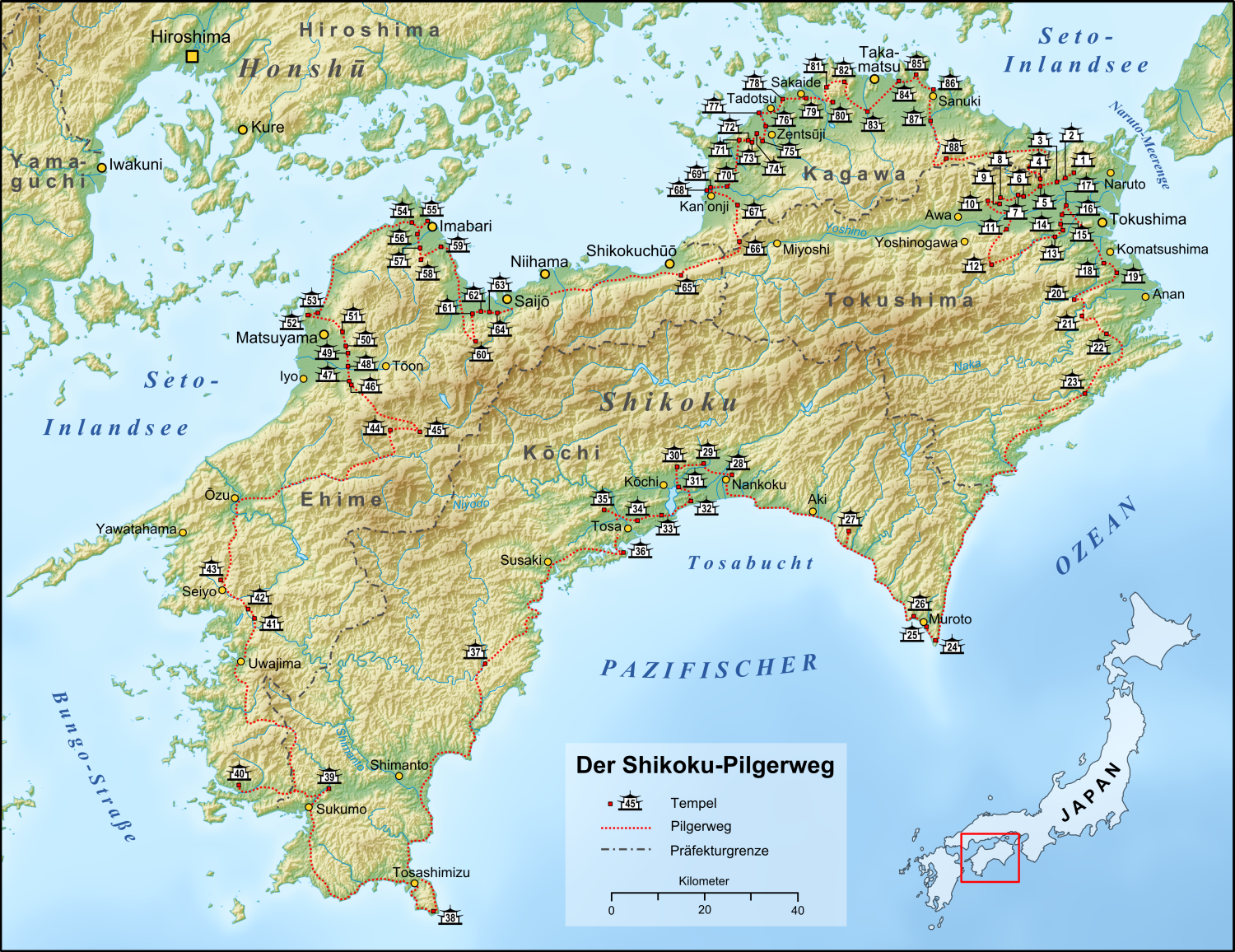Konnichiwa,
la preparazione continua e pensiamo, o almeno speriamo, che alcuni di voi non sappiano molto di questo pellegrinaggio nello Shikoku e siano curiosi di saperne di più. Eccoci quindi a darvi alcune informazioni.
Lo Shikoku è la più piccola della isole maggiori dell'arcipelago giapponese, e si trova nella sua parte meridionale. Le città più note nelle sue vicinanze sono Osaka e Hiroshima.
Come potete vedere dalla mappa, lo Shikoku è lungi dall'essere un'isola piatta, e ci sono interessanti (per il pellegrino 1) o spaventosi (secondo il pellegrino 2) sali e scendi lungo la strada. Potete anche vedere il profilo altimetrico del percorso che si affronta a piedi, che attraversando monti e valli a volte non offre strade asfaltate al pellegrino.
Non c'è un ordine prestabilito per completare il pellegrinaggio, in principio lo si può fare in senso orario o antiorario, oppure visitando i templi in ordine sparso a seconda della convenienza. Ci sono ad esempio pellegrini che completano il pellegrinaggio poco alla volta, camminando nel fine settimana o quando hanno tempo. Il modo usuale di percorrerlo è cominciando a tempio 1 e ritornarvi camminando in senso orario fino a tempio 88.
Narra la leggenda che un ricco mercante di nome Emon Saburo, dal cuore indurito dalla troppa ricchezza, abbia rifiutato a Kobo Daishi la carità di un pesce secco. Poco dopo venne colpito da una malattia, e riconoscendo il suo errore cominciò a seguire il pellegrinaggio con la speranza di incontrare il Daishi ed implorare il suo perdono. Dopo aver completato il percorso venti volte in senso orario e non avendolo mai incontrato, pensò che forse camminando in senso antiorario avrebbe finito per incontrarlo. Stremato dalla fatica si ammalò e, mentre era prossimo a morire, il Daishi gli apparve e gli concesse il suo perdono. Il mercante allora chiese di poter rinascere in una ricca famiglia per poter fare del bene, e morendo afferrò un sasso. Dopo nove mesi, nella città del mercante, nacque un bambino con la mano chiusa a pugno, che nessuno riusciva ad aprire. Venne chiamato un prete dal tempio vicino per investigare, e dopo aver invocato il Daishi il bambino aprì la mano, mostrando che vi stringeva una pietra su cui era scritto "Emon Saburo rinato".
Konnichiwa!.
Preparation is ongoing, but we guess, or at least we hope, some of you may not know really much about what this Shikoku pilgrimage is and are curious about it. Therefore here we are, giving you some general information.
First of all, where is Shikoku? Shikoku is the smallest of the main japanese islands, and its located in the Southern part of Japan, as you can see on this map. The closest and most known cities are Osaka and Hiroshima.
Shikoku is still a rural area, with very few cities an almost pristine environment. So, forget about Tokyo and all its futuristic buildings, here it's a complete different place. On the island there are, among others, 88 temples belonging to the Henro route, which is the pilgrimage we are going to cycle soon.
The location of these temples is shown on this other map (source).
As you can see, they are well distributed all over the island, and, since Shikoku is far from being a flat island, there are some nice (according to pilgrim 1) or dreadful (according to pilgrim 2) ups and downs along the road. Here is the altimetric profile of the walking route, which, crossing through mountains and valleys, has often no paved roads to support the pilgrims.
There is no given order or sequence for taking the pilgrimage, so in principle one could do it clockwise or counterclockwise, or jumping from a temple to another based on convenience. There are indeed people completing the pilgrimage over time, walking during weekends or when they have time, but the most usual way is to start at temple 1 and finish again there after travelling clockwise to temple 88. As we already said, we are starting at temple 75.
There is a story about a greedy merchant named Emon Saburo who, being cold hearted, refused Kobo Daishi the charity of a dried fish. Soon he was struck by an illness, and realizing his error, started walking the pilgrimage searching for the Daishi and his forgivness. After having completed the route clockwise twenty times and never succeding in meeting again the holy man, he thought that maybe walking counterclockwise he could have better fortune. The man got sick again and while he was about do pass away, Kobo Daishi appeared to him and granted him forgivness. The old man asked the Daishi to be reborn in wealth family so that he could make good deeds, and while passing away he grabbed a stone. Nine months after, in the city of the merchant, a baby was born with his hand closed in a fist, and nobody was able to open it. A priest from the local temple was called to investigate, and after worshipping the Daishi the baby opened his hand, showing that he had a stone on which it was written "Emon Saburo is reborn".



Nessun commento:
Posta un commento